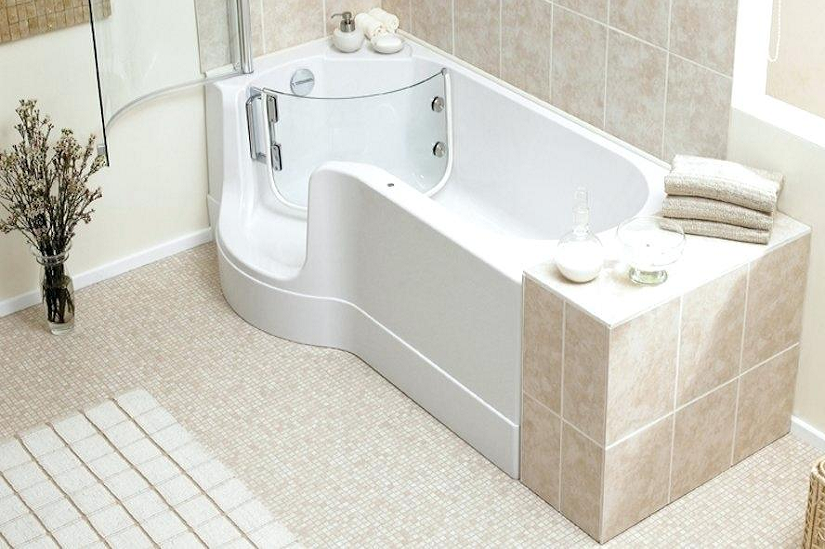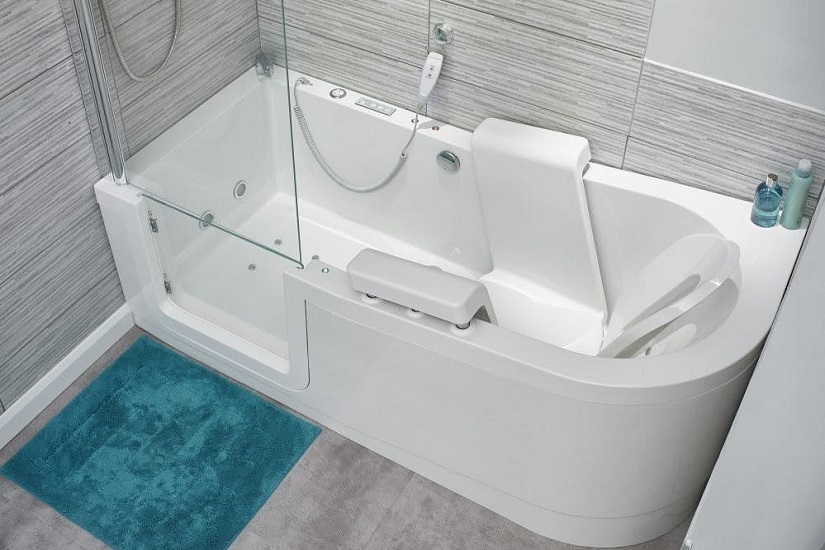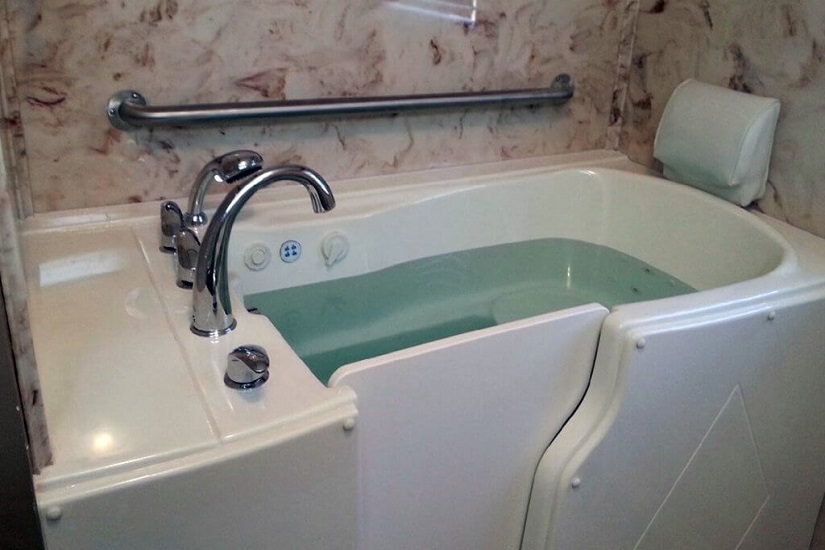It’s essential to consider the architecture of your home if you have limited mobility. This includes purchasing items that make your living space more accessible and secure. Walk-in tubs, also known as step-in tubs, are one example. They are a more secure option than typical tubs that require you to cross a high threshold. Walk-in tubs are easier to enter, providing you with a greater sense of independence, comfort, and security.
Keep on reading if you’re considering getting a walk-in bathtub. We’ll be looking at the benefits and drawbacks of them.
What are Walk in Bath Tubs:
As the name suggests, a walk-in bathtub is built to allow you to walk right into it. It comes with a watertight door that allows the user to enter the tub safely over a low threshold. Generally, it works by closing the door and filling the tub with water. The user opens the door and steps out securely after draining the bath.
This is designed for persons who have difficulty climbing in and out of ordinary bathtubs, removing many risks of sliding and falling. Instead of having an extra horizontal room like a regular bathtub, this is accomplished by adding more vertical features to the bathtub design.

Features Of A Walk-In Tub:
| ADA SAFETY GRAB BAR | EXTENSION KIT |
| HEADREST PILLOW | AIR MASSAGE THERAPY |
| REINFORCED FIBERGLASS | LIFETIME WARRANTY DOOR SEAL |
| CONTOURED SEAT | OVERFLOW PROTECTIVE DRAIN |
| AROMATHERAPY | LEFT OR RIGHT TUB DOOR |
| ROMAN FAUCET SET | HYDRO MASSAGE THERAPY |
| CHROMATHERAPY | INLINE HEATER |
| HAND-HELD SHOWER | ADA 17″ SEAT HEIGHT |
| REMOVABLE ACCESS PANELS | TUB DOOR PROTECTIVE DRAIN |
| RAPID AUTO DRAIN | NON-SLIP FLOOR |
Many walk-in bathtubs have footholds and handlebars, as well as seats, so you don’t have to stand while bathing, putting less strain on your legs. What an advantage!
While many versions are taller than they are wide, there are various types and configurations to suit nearly any type of bather and housing circumstance. For example, some can open virtually the whole front of the walk-in tub to provide the necessary width for wheelchair access to the tub seat.
Pros and Cons of Walk-in Tubs:
Benefits of walk-in tubs:
Bathing can be challenging for seniors and people with disabilities. Getting in and out of a typical shower or tub can be inconvenient and dangerous as well. Modern walk-in bathtubs, on the other hand, make bathing more convenient. The following are some of the advantages of having a walk-in tub.

Deeper Water Depth:
Compared to standard tubs, walk-in tubs can have deeper water depth, because a sealed entry-way allows the bath’s walls to be higher while still allowing for easy access. Conventional bathtubs typically have a depth of 13 to 14 inches. However, walk-in tubs can have a water depth of nearly four feet for a comfortable bathing experience while the user is also safely seated.
Seats are typically 17 inches high, leaving nearly 20 inches of depth to immerse the torso (which is well within the average adult torso length). Many walk-in tub types offer hydrotherapy jets and other luxurious features like chromotherapy lighting and heated chairs.
Walk-in tub Health Benefits:
Bathing in a walk-in tub is safe and easy, and it can also benefit your general health in several ways:
- Relief from illness: The relaxing qualities of a walk-in tub can help those suffering from diseases such as arthritis, diabetes, rheumatism, fibromyalgia, or general muscular or joint pain and stiffness.
- Boost your circulation: A walk-in tub can also aid general circulation, enhancing mobility and reducing pain.
Relax and de-stress in a walk-in tub:
A walk-in tub provide tranquility as well as a pleasant and stress-relieving experience. Its calming air bath capabilities like chroma therapy, hydrotherapy, and massages might also users attain better sleep.
Safety Features:
A lot of the remodeling is focused on safety, especially on preventing dangerous falls among the elderly. Every year, more than one-third of seniors aged 65 or more fall, with over 80% of those falls occurring in the restroom. In general, walk-in tubs have a number of elements that help to prevent falls.
The Standard Features are:
- Built-in handrails.
- An ADA-compliant overall design.
- Non-slip flooring.
- Contoured built-in seats.
- A low entry step height.
Some types have large doors that make it easier for wheelchair users to transfer to the tub seat without assistance.
Combined Characteristics:
Some walk-in tub types include numerous functions in a single tub. Rather than purchasing add-on handrails, anti-scald valves, and non-slip flooring separately, walk-in tubs often have all these features in one.
This can cut down on the quantity of renovation work required in your bathroom as well as the time it takes to complete the project.
Hydrotherapy:
Warm water has long been recognized to help elders with aches and pains and to expedite the healing of ailments such as burns and ulcers. Patients healing from amputations or suffering from illnesses like arthritis may benefit from hydrotherapy.
Many step-in tubs contain hydrotherapy jets similar to those found in outdoor hot tubs, in addition to their relaxing, deep, warm water. Meanwhile, air jets swirl the water and soothe the muscles, providing even more of an ultimate experience.
Disadvantages Of A Walk-In-Tub:
We have discussed some of the benefits that come with the walk-in-tubs. Now, let us have a look at some of the potential disadvantages of owning a walk-in-tub:

Fill and Drain Times for walk-in tubs:
In a walk-in tub, you must enter the tub before filling it, and you cannot open the doors until it has been drained. Because walk-in tubs take around 7 minutes to fill or drain, it’s very important to start with a safe, comfortable temperature and maintain it for as long as possible. Warming chairs and rapid drains can help you stay warm while bathing, and a scald protection valve is essential for avoiding dangerously hot water from coming into contact with you.
Walk-in tub Water Usage:
Many water heaters struggle to keep up with the demand of walk-in tubs, which carry far more water than ordinary tubs. If you’re considering purchasing a large walk-in tub, check with the manufacturer to see if your water heater is capable of handling the demand.
Water Usage:
| Standard Tub | Standard Shower | Walk-in Tub |
| 42-80 Gallons | 25-40 Gallons | 50 gallons |
However, not all walk-in tubs store enough water to cause this issue. A typical tub contains 42 to 80 gallons of water, although many walk-in tubs hold roughly 50 gallons.
Walk-In Tubs Cost:
Now the question comes how much do walk-in tubs cost? Walk-in tubs are more expensive than regular bathtubs, especially when installation is factored in. The majority of walk-in baths cost between $2,000 and $5,000, not including induction, and prices rise as you add additional features.
If the cost of a walk-in tub seems prohibitive upfront, ask about financing alternatives to spread the cost over time. Consider the expenses of other options to a walk-in tub as well.
While Medicare does not pay the cost of a walk-in tub, several states do provide financial aid to help cover the initial expenditures. It can help to do a bit of research to discover whether such a program exists in your state or locality.
Installation of a walk-in tub:
Professional installation is required for many walk-in tubs, and this service is not typically included in the purchase price. Before a walk-in tub can be constructed, some homes, particularly older ones, may need to update their electrical and plumbing systems. Your walk-in tub provider can help you figure out what has to be done before the tub is installed.
A walk-in tub installation, on the other hand, does not have to be complicated. Installing certain walk-in baths is less expensive than others. Gelcoat tubs are, on average, easier to lift and move, making them easier to install. Durable acrylic tubs are heavier and take more time to install.
Flooding:
While the majority of tubs have swing-in doors, others have swing-out doors for easy access. Swing-out doors make it simpler to enter the tub, but they also increase the risk of flooding if the door is not correctly fastened.
The weight of water in a full tub could cause the door to open, resulting in water flooding into your home if it is not closed securely. While doors are watertight, there is always the possibility of a seal failure, resulting in leaks or flooding.
Who Should Buy Walk-In Tubs?
Anyone with limited mobility may benefit from a walk-in bathtub, such as persons with impairments or people who are aged. Caregivers and family members of those with limited mobility will benefit from them as well.
Final Verdict:
Conclusively, for many people considering purchasing a walk-in tub, the benefits outweigh the disadvantages. Overall, anyone looking for a safer, more pleasant bathing experience might benefit from a walk-in tub.

